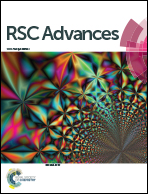Fast and highly sensitive humidity sensors based on NaNbO3 nanofibers†
Abstract
A humidity sensor based on NaNbO3 nanofiber networks was fabricated through the electrospinning process. The as-synthesized NaNbO3 nanofibers with monoclinic perovskite structure are uniformly distributed and integrated by interdigital Pt/Ti electrodes on alumina substrates. The sensor exhibits fast and ultra-sensitive resistance type response to the variation of environmental humidity at room temperature. The sensor resistance is in logarithmic dependence on the relative humidity. The highest sensitivity is up to 105 for the humidity change from 20 to 80% RH. Moreover, the response time for the humidification process is less than 3 s. The response time for the dehumidification process is slower due to the slower desorption of water molecules. In addition, the sensor exhibits outstanding selectivity against hydrogen, ethanol, and acetone steam. Among them, the sensitivity to ethanol steam is 5 orders of magnitude smaller than that to humidity, while no sensing response is found for hydrogen and acetone. According to the fully recovered performance and non-sensing behavior to hydrogen, the sensing behavior of the nanofibers could be attributed to the electrical-field-driven transfer of proton between H3O+ induced by the physisorption of water molecules.


 Please wait while we load your content...
Please wait while we load your content...